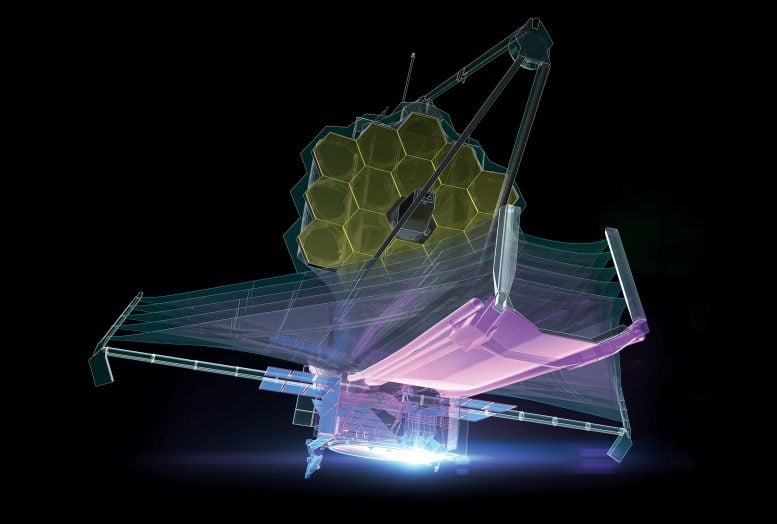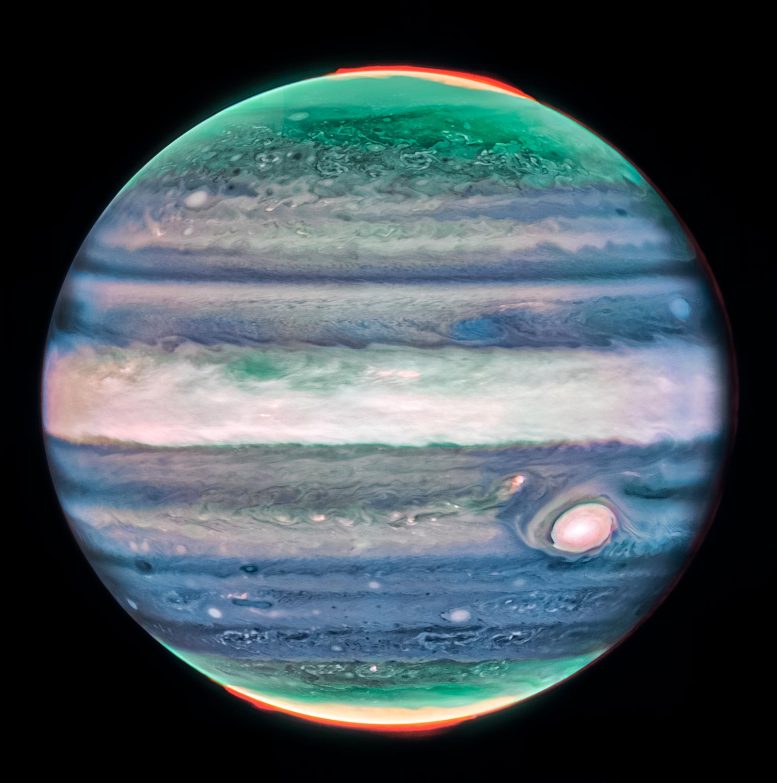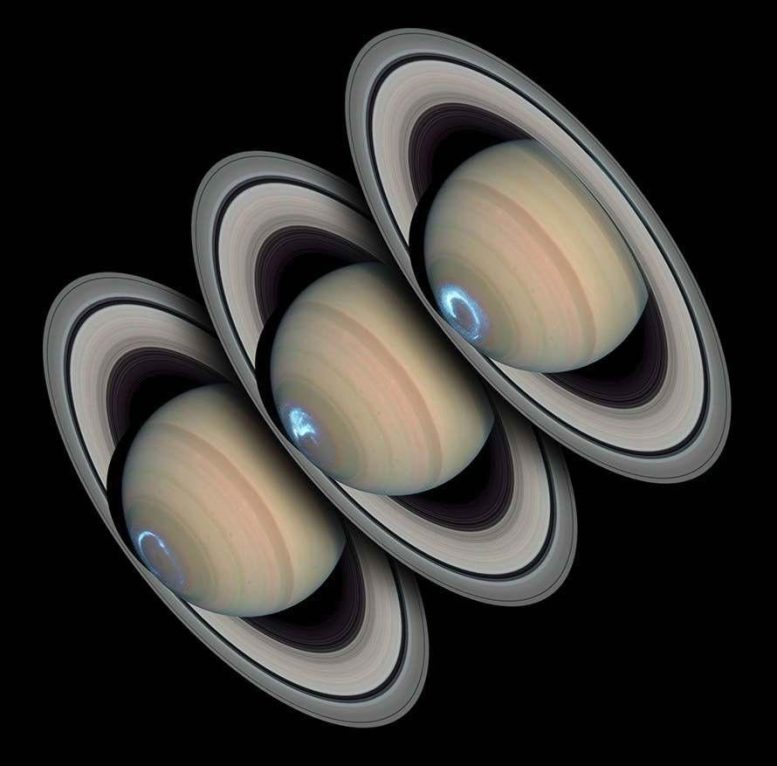
Long-Sought Auroral Glow Finally Emerges Under Webb’s Powerful Gaze
Neptune lies in the cold, dark reaches of the outer edges of our solar system, about 3 billion miles from the Sun, at the farthest edge of the planetary lineup.
Only one spacecraft has ever flown by: NASA’s Voyager 2 in 1989. Since then, telescopes like Hubble have kept watch from afar, tracking Neptune’s dynamic weather and even discovering a new moon in 2013.
Often seen as a serene bluish orb, Neptune occasionally sports dark spots that appear and vanish without warning. But now, NASA’s James Webb Space Telescope has revealed something entirely new: a brilliant, glowing aurora shimmering across the planet’s atmosphere, captured in stunning infrared detail for the first time.

Auroras occur when energetic particles, often originating from the Sun, become trapped in a planet’s magnetic field and eventually strike the upper atmosphere. The energy released during these collisions creates the signature glow.
Credit: NASA, ESA, CSA, STScI, Heidi Hammel (AURA), Henrik Melin (Northumbria University), Leigh Fletcher (University of Leicester), Stefanie Milam (NASA-GSFC)
Webb Space Telescope Captures Neptune’s Auroras For First Time
For the first time, NASA’s James Webb Space Telescope has clearly captured bright auroras on Neptune. Auroras form when high-energy particles, often from the Sun, are trapped by a planet’s magnetic field and collide with its upper atmosphere, producing a glowing light display.
Astronomers had previously seen hints of auroral activity on Neptune, including during NASA’s Voyager 2 flyby in 1989. But unlike on Jupiter, Saturn, and Uranus, confirming and imaging Neptune’s auroras had remained out of reach, making it the last of the giant planets without direct evidence of this phenomenon.
Webb’s Sensitivity Makes the Difference
“Turns out, actually imaging the auroral activity on Neptune was only possible with Webb’s near-infrared sensitivity,” said lead author Henrik Melin of Northumbria University, who conducted the research while at the University of Leicester. “It was so stunning to not just see the auroras, but the detail and clarity of the signature really shocked me.”
The data was obtained in June 2023 using Webb’s Near-Infrared Spectrograph. In addition to the image of the planet, astronomers obtained a spectrum to characterize the composition and measure the temperature of the planet’s upper atmosphere (the ionosphere). For the first time, they found an extremely prominent emission line signifying the presence of the trihydrogen cation (H3+), which can be created in auroras. In the Webb images of Neptune, the glowing aurora appears as splotches represented in cyan.

In Webb’s images of Jupiter from July 2022, researchers recently discovered a narrow jet stream traveling 320 miles per hour (515 kilometers per hour) sitting over Jupiter’s equator above the main cloud decks. Credit: NASA, ESA, CSA, STScI, Ricardo Hueso (UPV), Imke de Pater (UC Berkeley), Thierry Fouchet (Observatory of Paris), Leigh Fletcher (University of Leicester), Michael H. Wong (UC Berkeley), Joseph DePasquale (STScI)
Trihydrogen Glow: The Auroral Signature
“H3+ has a been a clear signifier on all the gas giants — Jupiter, Saturn, and Uranus — of auroral activity, and we expected to see the same on Neptune as we investigated the planet over the years with the best ground-based facilities available,” explained Heidi Hammel of the Association of Universities for Research in Astronomy, Webb interdisciplinary scientist and leader of the Guaranteed Time Observation program in which the data were obtained. “Only with a machine like Webb have we finally gotten that confirmation.”
The auroral activity seen on Neptune is also noticeably different from what we are accustomed to seeing here on Earth, or even Jupiter (see image above) or Saturn (see image below). Instead of being confined to the planet’s northern and southern poles, Neptune’s auroras are located at the planet’s geographic mid-latitudes — think where South America is located on Earth.
This is due to the strange nature of Neptune’s magnetic field, originally discovered by Voyager 2 in 1989, which is tilted by 47 degrees from the planet’s rotation axis. Since auroral activity is based where the magnetic fields converge into the planet’s atmosphere, Neptune’s auroras are far from its rotational poles.

Solar Winds Meet an Ice Giant
The ground-breaking detection of Neptune’s auroras will help us understand how Neptune’s magnetic field interacts with particles that stream out from the Sun to the distant reaches of our solar system, a totally new window in ice giant atmospheric science.
From the Webb observations, the team also measured the temperature of the top of Neptune’s atmosphere for the first time since Voyager 2’s flyby. The results hint at why Neptune’s auroras remained hidden from astronomers for so long.
“I was astonished — Neptune’s upper atmosphere has cooled by several hundreds of degrees,” Melin said. “In fact, the temperature in 2023 was just over half of that in 1989.”
Why Neptune’s Auroras Were Hidden So Long
Through the years, astronomers have predicted the intensity of Neptune’s auroras based on the temperature recorded by Voyager 2. A substantially colder temperature would result in much fainter auroras. This cold temperature is likely the reason that Neptune’s auroras have remained undetected for so long. The dramatic cooling also suggests that this region of the atmosphere can change greatly even though the planet sits over 30 times farther from the Sun compared to Earth.
Equipped with these new findings, astronomers now hope to study Neptune with Webb over a full solar cycle, an 11-year period of activity driven by the Sun’s magnetic field. Results could provide insights into the origin of Neptune’s bizarre magnetic field, and even explain why it’s so tilted.
Future Missions and Lasting Impact
“As we look ahead and dream of future missions to Uranus and Neptune, we now know how important it will be to have instruments tuned to the wavelengths of infrared light to continue to study the auroras,” added Leigh Fletcher of Leicester University, co-author on the paper. “This observatory has finally opened the window onto this last, previously hidden ionosphere of the giant planets.”
These observations, led by Fletcher, were taken as part of Hammel’s Guaranteed Time Observation program 1249. The team’s results have been published in Nature Astronomy.
Reference: “Discovery of H3+ and infrared aurorae at Neptune with JWST” by Henrik Melin, Luke Moore, Leigh N. Fletcher, Heidi B. Hammel, James O’Donoghue, Tom S. Stallard, Stephanie N. Milam, Michael Roman, Oliver R. T. King, Naomi Rowe-Gurney, Emma E. Thomas, Ruoyan Wang, Paola I. Tiranti, Jake Harkett and Katie L. Knowles, 26 March 2025, Nature Astronomy.
DOI: 10.1038/s41550-025-02507-9
The James Webb Space Telescope is the world’s leading space science observatory, designed to explore the universe in unprecedented detail. As an international collaboration between NASA, the European Space Agency (ESA), and the Canadian Space Agency (CSA), Webb is unlocking mysteries within our solar system, studying planets around distant stars, and investigating the structure and origins of the universe. With its powerful infrared capabilities, Webb is helping scientists better understand how galaxies, stars, and planetary systems, including our own, formed and evolved.
Never miss a breakthrough: Join the SciTechDaily newsletter.
3 Comments
Neptune is undergoing climate change, quick we need to stop it before its too late!
All new discoveries are Amazing, what would Galeo do ??
Looking forward to exciting new discoveries.